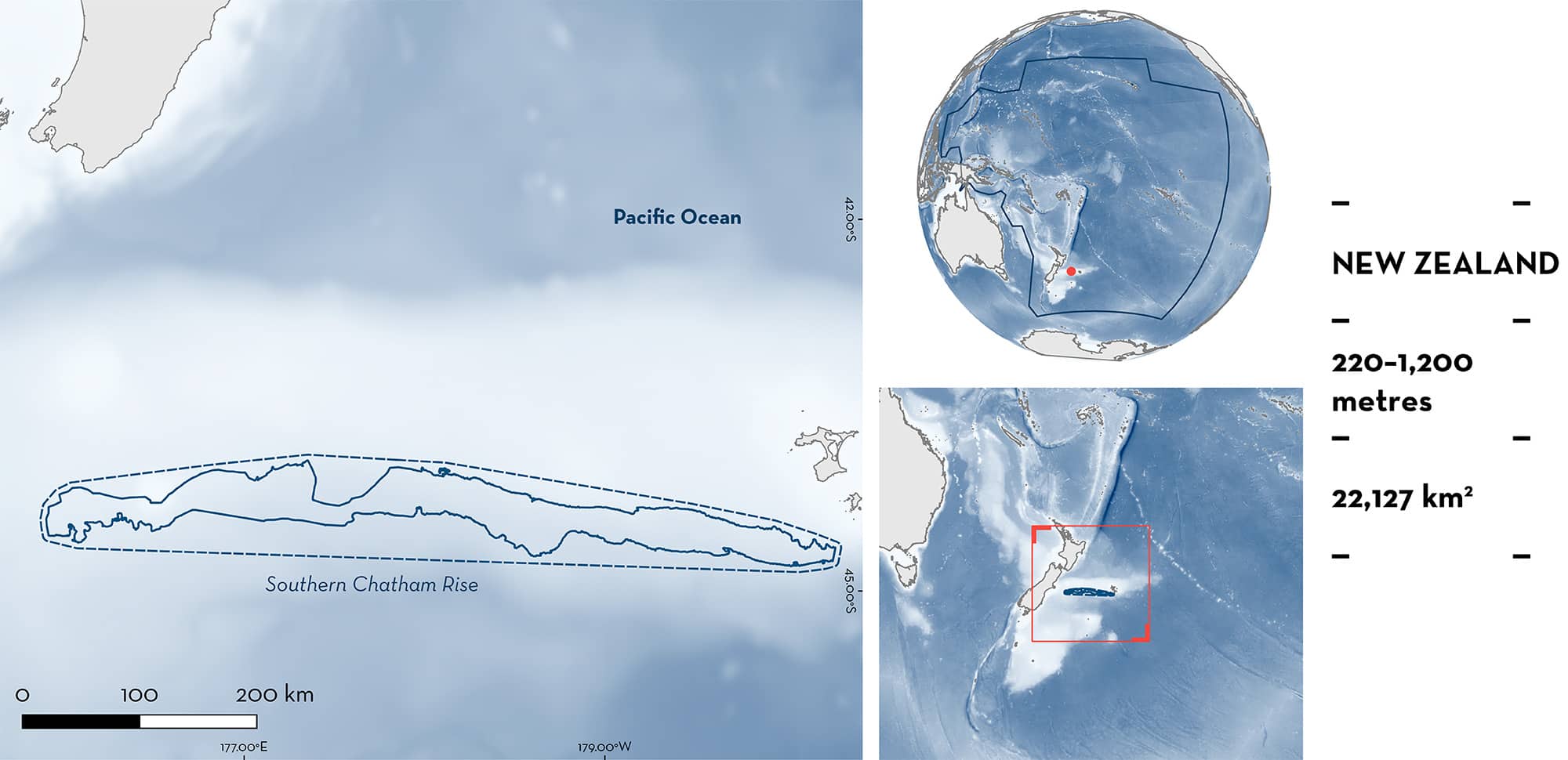ISRA FACTSHEETS
ISRA FACTSHEETS
NEW ZEALAND & PACIFIC ISLANDS REGION
Southern Chatham Rise
Summary
Southern Chatham Rise is located in the southern part of a ridge on the eastern side of New Zealand. It is characterised by muddy and sandy substrates. The area is dominated by the Subtropical Front where subtropical waters and subantarctic waters mix. The area overlaps with the Chatham (offshore) Key Biodiversity Area. Within this area there are: range-restricted species (e.g., Pale Ghostshark Hydrolagus bemisi) and reproductive areas (Southern Lanternshark Etmopterus granulosus).
Download factsheet
Southern Chatham Rise
DESCRIPTION OF HABITAT
Southern Chatham Rise is located in the southern part of a ridge on the eastern side of New Zealand. It rises from deep areas to 50 m in the western side and to sea level near the Chatham Islands (McGregor et al 2019). The area is characterised by abyssal hills with muddy and sandy substrates (Nodder et al. 2003). Phosphorite nodules are spread around the crest of the rise along with exposed basement rock substrates (Bowden et al. 2017; Leduc et al. 2024). These habitats sustain large densities of deep-water corals (Leduc et al. 2024). The area has a stable and permanent oceanography dominated by the Subtropical Front where there is a mix of subtropical waters and subantarctic waters (Sutton 2001; Chiswell et al. 2015). North subtropical waters are warmer, more saline and nutrient poor compared to the cold and nutrient rich subantarctic waters from the south (McGregor et al. 2019). This front is divided by a frontal zone in the north and south (Sutton 2001). Sea surface temperatures are warmer during austral autumn with a shallow mixed layer in subtropical waters while in spring, temperatures are cooler and there is a deeper mixed layer (Sutton 2001). Due to the oceanographic and habitat features in the rise, this area has the highest species richness for demersal fishes (Leathwick et al. 2006).
The area overlaps with the Chatham (offshore) Key Biodiversity Areas (KBA 2024a; 2024b).
This Important Shark and Ray Area is benthic and subsurface and is delineated from 220 m to 1,200 m based on the bathymetry of the area.
CRITERION B
RANGE RESTRICTED
This area holds the regular presence of the New Zealand Catshark, Brown Chimaera, Giant Chimaera, Australasia Narrow-nosed Spookfish, and Pale Ghostshark. These species were regularly encountered in independent research surveys using demersal trawls (200–1,300 m) conducted in January–February annually from 2009–20124 and bi-annually since 2014 (O’Driscoll et al. 2011; Stevens et al. 2012, 2013, 2014, 2015, 2017, 2018, 2021, 2023; B. Finucci unpubl. data 2024). Due to the fishing gear selectivity, the abundance recorded for some of the species is underestimated and does not represent their true abundances in the area.
For New Zealand Catshark, 58 individuals were recorded between 2020–2024. Species-specific catch records prior to 2020 are not available, as both species were recorded as ‘catsharks’. This area had the largest number of New Zealand Catshark caught during research surveys around all of New Zealand (B Finucci unpubl. data 2024). This species is endemic to the New Zealand Shelf Large Marine Ecosystem (LME).
For Brown Chimaera, 48 individuals were recorded in the area between 2009–2024 (except 2013, 2015, 2019 and 2023) with Southern Chatham Rise having the second largest number of individuals recorded during research surveys for this species in all New Zealand. This species occurs in the New Zealand Shelf LME and in the Southeast Australian Shelf LME.
For Giant Chimaera, 11 individuals were recorded in the area in 2009, 200, 2012, and 2020. Despite the low numbers, Chatham Rise represents the largest number of individuals recorded during research surveys for this species in all New Zealand. This species is endemic to the New Zealand Shelf LME.
For Australasia Narrow-nosed Spookfish, 880 individuals were recorded in the area between 2009–2024 with Southern Chatham Rise having the third largest number of individuals recorded during research surveys for this species in all New Zealand. This species is endemic to the New Zealand Shelf LME.
For Pale Ghostshark, 1,073 individuals were recorded in the area between 2009–2024 with Central Chatham Rise having the third largest number of individuals recorded during research surveys for this species in all New Zealand. This species is endemic to the New Zealand Shelf LME.
CRITERION C
SUB-CRITERION C1 – REPRODUCTIVE AREAS
Southern Chatham Rise is an important reproductive area for one shark species.
Based on records from research demersal trawl surveys conducted in yearly between January–February from 2009–2014 and bi-annually since 2014 (O’Driscoll et al. 2011; Stevens et al. 2012, 2013, 2014, 2015, 2017, 2018, 2021, 2023) young-of-the-year (YOY) individuals and late-stage pregnant females (with near-term embryos) of Southern Lanternshark are regularly found in the area (B Finucci unpubl. data 2024). Species maturity was assessed at sea using the National Institute of Water and Atmospheric Research’s standard shark macroscopic maturity staging key. YOY were determined either through physical assessment at sea or estimated from published growth curves based on their size (Irvine 2004).
For Southern Lanternshark, 5,386 individuals were caught. Of these, 251 (4.6% of catches) YOY and 78 late-stage pregnant females were caught at depths of 500–1,135 m. YOY were defined as individuals measuring <25 cm TL (Irvine 2004). Southern Chatham Rise was the area with the largest number of YOY sampled in all New Zealand.
Download factsheet
SUBMIT A REQUEST
ISRA SPATIAL LAYER REQUEST
To make a request to download the ISRA Layer in either a GIS compatible Shapefile (.shp) or Google Earth compatible Keyhole Markup Language Zipped file (.kmz) please complete the following form. We will review your request and send the download details to you. We will endeavor to send you the requested files as soon as we can. However, please note that this is not an automated process, and before requests are responded to, they undergo internal review and authorization. As such, requests normally take 5–10 working days to process.
Should you have questions about the data or process, please do not hesitate to contact us.


